May-26-14
 | | GrahamClayton: 25. ♕d7+ ♔g8 26. ♕xb7 winning a pawn loses after 26...♕e4+, eg 27. ♔g1/h1 ♖xh1#, or 27. f3 ♕e2+ 28. ♔g1 ♕xd1+ 29. ♔f2 ♖xh1. |
|
Jan-29-19
 | | KEG: Popiel (I will omit the "von" in referring to von Popiel and von Gottschall in commenting on this game) had some good results at Munich 1900. He drew with Maroczy, Marco and Cohn and defeated Janowski and Showalter. But he (needlessly) lost this game to Gottschall and drew with Halprin and Billecard. In this game against Gottschall, Popiel outplayed his opponent and obtained a winning position, gave up his advantage with sloppy play, then got a winning Rook and pawn ending after errors by Gottschall, and then managed to lose this ending he should have won. Had he won this game, Popiel could have ended in a tie with Berger, Janowski, and Showalter for 7th place (a respectable finish). Instead, he ended up tied for 11th (with a losing record) with Gottschall. All in all, this is not a very good game. Its main interest is its display of the kinds of mistakes non-elite players can make. 1. e4 e5
2. Bc4
Bishop's Opening. Popiel obtained no advantage from this opening. 2... Nf6
3. d3 Bc5
4. Nc3 d6
5. Nf3 c6
6. 0-0 0-0
Chances here were about even:
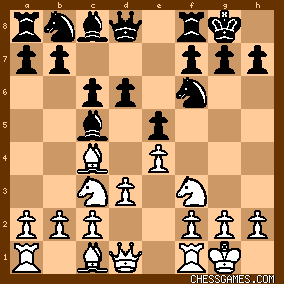
click for larger view7. Be3
Hardly best, since it allows Black to trade Bishops and weaken White's pawn structure. 7. a4 was among the moves that would have yielded an approximately even game for Popiel. 7... Bb6
He could and should have played 7...BxB
8. BxB axB
9. h3 Be6
9...b5 followed by 10...b4 was better.
10. BxB fxB
This left:

click for larger view11. Ne2
Popiel could have obtained an edge with 11. a4 or 11. d4. 11... Nh5
12. d4
The position was now:

click for larger view12... Nf4
This made Gottshcall's position difficult. He could have made things very interesting with 12...RxN?! This would give Black attacking chances and decent compensation for the sacrificed exchange. Instead, Gottschall chose to trade pieces and except an inferior position. 13. NxN exN
This left:
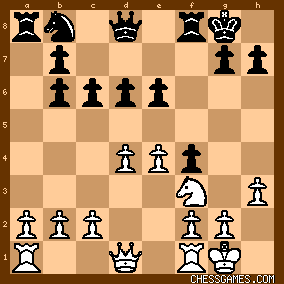
click for larger viewWhite is better here, but the game need not have turned into a lost one for Black. How Popiel ended up with a won game from the above position in just six moves will be discussed in my next post on this game. |
|
Jan-29-19
 | | KEG: Post II
14. Qd3 Nd7
Finally developing his remaining minor piece.
15. a3
Unambitious but solid. 15. a4 and 15. Qb3 were more forceful efforts to vie for the initiative. 15... Kh8
Very passive. 15...b5 and 15...Qe7 were both somewhat better. 16. Rad1
16. c4 was White's best chances to play for an advantage here. 16... g5?!
An unnecessary weakening that was the beginning of Gottschall's troubles. Given his play to this point, he should have tried to hang tough with 16...Qe7 or 16...Qe8 or 16...Qf6. The position was now:

click for larger view17. g4?!
Popiel decided to get his Rook to h1 and attack on the King-side. 17. Qc3 getting the Queen on the now weak c3...h8 diagonal was, however, a better attempt to punish Gottschall's reckless 16...g5?! 17... Qf6
Better chances were offered by seizing the chances to take en passant with 17...fxg3 or perhaps guarding the now weak h2 pawn with 17...Rf7 or 17...Qe7. 18. Kg2
Fixated on his effort to get his Rook to h1, Popiel misses the more pressing 18. e5 or 18. Qc3. But even with the text, White is much better. 18. Qb3 was also an interesting possibility. 18... Kg7
The beginning of a bad idea involving the placement of his Rook on h8. Gottschall should have either sought counterplay with 18...b5 or some effort at effective defense of the King-side with 18...Qe7 or 18...Rf7. 19. Rh1
According to plan.
The position was now:

click for larger viewGottschall could still have defended with 19...Rf7 or 19...Kg8. But instead he played: 19... Rh8?
20. h4
This powerful advance could have been the beginning of the end for Gottschall. Even stronger was 20. e5. In either case, Black was in trouble. 20... h6?
20...hxg4 was not attractive but was probably the only way for Black to have a decent chance to hang on. The position was now:

click for larger viewAs I will discuss in my next post on this game, Popiel here had a winning attack at his disposal, but within just a few moves lost all of his advantage. |
|
Jan-29-19
 | | KEG: Post III
In the diagrammed position with which I ended my last post, Popiel could have played 21. e5. Black has no good response. If 21...dxe5 (probably best play), White has a win with 22. dxe5 Nxe5 23. NxN QxN 24. Rhe1 Qd5+ 25. QxQ exQ 26. Re7+ Kg8 27. Rxb7 leaving Black helpless. If instead (after 21. e5) 21...Qg6 White wins with 22. QxQ+ KxQ 23. exd6 gxh4 24. Rxh4 and White wins easily. But Popiel missed this possibility and let Gottschall back in the game with: 21. hxg5? hxg5
22. e5?
"!"--Tournament Book.
The Tournament Book notwithstanding, the text gave away most of what was left of White's advantage. Popiel should have played 22. Qc3. If then 22...d5 (best) 23. exd5 exd5 24. Rdh1 RxR 25. RxR Rh8 26. RxR KxR 27. Qe1 with good chances for White. After Popiel's actual 22. e5, the position was:
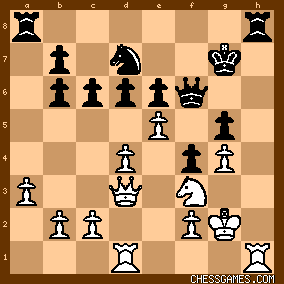
click for larger view22... dxe5
23. exd5
23. RxR or 23. Qe4 were better.
23... Nxe5
Obviously forced.
24. NxN?
24. RxR was the only chance to retain any advantage at all. White gives up his Queen for two Rooks in this line (24. RxR NxQ 25. RxR Ne5 26. c3 NxN 27. Rd7+ Kg6 28. Rg8+ Kh6 29. KxN, but is is doubtful that White can win the two Rooks for Queen and pawn ending. After the text, chances are pretty much even.
24... QxN
This left:
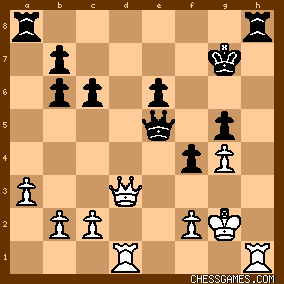
click for larger viewPopiel was at least temporarily down a pawn, but he seems sure to win it back with a draw the likely outcome. User Graham Clayton correctly notes that 25. Qd7+? is bad, but his analysis is flawed. After 25. Qd7+ Graham Clayton's proposed 25...Kg8?? loses, not to the suggested 26. Qxb7 (after which Black mates White beginning with 26...Qe4+) but with 26. RxR+ KxR 27. Rh1+ Kg8 28. Qh7+ Kf8 29. Qh8+ (winning a Rook and the game). Best after 25. Qd7+ is 25...Kf6 leaving White in serious trouble. So 25. Qd7+ is bad. Popiel here played the far better: 25. Rde1
"!"--Tournament Book.
The position was now:
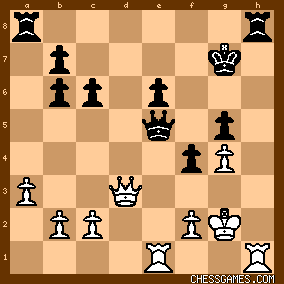
click for larger viewWith 25...Qf6, Gottschall should have been able to hold the game. But instead he blundered with: 25... Qd5+?
All of a sudden, Gottschall was lost again:
26. QxQ exQ?
26...cxQ was not pretty, but now the floodgates open and Popiel should have been able to win easily: 27. Re7+ Kg6
28. RxR RxR
29. Rxb7 Rh4
This left:

click for larger viewThis sure looks like a win for White. Popiel, however, as I will discuss in my next post on this game, managed to throw away his win on his very next move and to land himself in a hopelessly lost ending five moves later. |
|
Jan-30-19
 | | KEG: Post IV
The win for White in the diagrammed position seems clear. He picks up the Black b-pawn and then marches his a-pawn down the board. Black's King and Rook are out of place, and seem helpless. But a modicum of care is required. Popiel had to make sure that Gottschall didn't get chances of his own on the King-side. Therefore, he had to protect his g-pawn before taking on b6. 30. Kf3 wins, but this allows Black to pick up the g-pawn after 30...Rh3+ 31. Ke2 Rh4 32. Rxb6 Rxg4 33. Rxc6+ Kf5 34. b4. The clearest way to win is with the simple 33. f3. Now Black is helpless (e.g., 30...Rh8 31. Rxb6 Rc6 32. a4 or 30...b5 31. Rb6 Kf7 32. Rxc6). But Popiel rashly played:
30. Rxb6?
"?"--Tournament Book.
Now, the win was gone:
30... Rxg4+
31. Kf3
31. Kf1 was not much better (31...Kf5 32. Rxc6 [32. f3 Rg3] f3! and White has to worry about mating nets allowing Black to draw, 31... Rg1
The position was now:
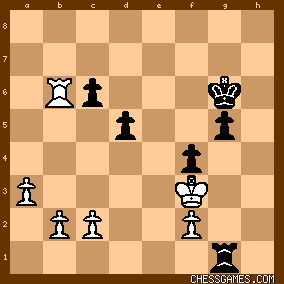
click for larger viewGottschall was now poised to play Kf5, and thus White's win was goen. 32. Rxc6
Neither 32. Rb8 or 32. Rb7 are any better.
32... Kf5
33. Ke2
If. 33. Rc8 Black gets in 33...g4+ 34. Ke2 f3+ 35. Ke3 Re1+ 36. Kd3 Rd1+ 37. Kc3 Rf1 and White cannot win. 33... g4!
33...Rb8 also draws. I bet around now that Popiel wished he had played 30. f3 The position was now:

click for larger viewRemarkably enough, White here had only one move to save the game, which he found: 34. Rc8!
If, for example, 34. a4?? Black wins after 34...f3+ 35. Ke3 Re1+ 36. Kd2 Re2+. And 34. Rb7 loses to 34...f3+ 35. Kd2 [White can even get mated after 35. Ke3 Re1+ 36. Kd3 Rd1+ 37. Ke3?? d4 mate] Rf1 36. Ke3 d4+. 34... f3+
This left:

click for larger viewWith his Rook on c8, White can now hold the game with 35. Ke3 [or 35. Kd3] Re1+ 36. Kd3 Rd1+ 37. Kc3 [not 37. Ke3?? d4 mate] Rf1 38. Rf8+ and White can keep checking since if the King comes to g6 he has Rg8+. But here Popiel, having thrown away the win, now threw away his chance to draw with: 35. Kd2?? Rf1!
The position was now:

click for larger viewI will discuss Gottschall's mopping up operation from this position in my next post on this game. |
|
Jan-31-19
 | | KEG: Post V
After 35...Rf1!, Popiel was dead lost. He was dead on the King-side. But the wrap-up which should have been simple had its moments: 36. Rf8+
If 36. Ke3 d4+ 37. Kxd4 Rxf2 and Black's pawns cannot be stopped. 36... Ke5
37. Re8+
37. b4 is too slow (37...Rxf2+ 38. Kc3 [if 38. Ke3 Rxc2] d4+ 39. Kd3 g3 ). 37... Kf6
37...Kf4 also wins.
38. Rg8
38. Rf8+ is slightly more taxing, but Black still wins with 38...Ke7 39. Rf4 Rxf2+ 40. Ke3 Re2+ 41. Kd3 Rg2 38... Rf2+
39. Kd3
If 39. Ke1 Re2+ 40. Kf1 Rg2
The position after 39...Kd3 was:
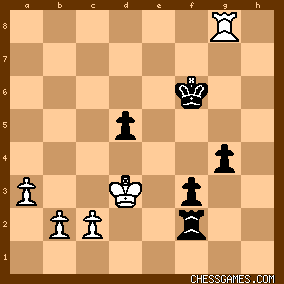
click for larger view39... Kf5
39...Rg2 would also win quickly.
40. a4
This should not have gotten Popiel anything, but it seems to have perplexed Gottschall and gotten him off track for a moment. 40... Rf1
This wins, but 40...Kf4 was immediately decisive. 41. a5
Pursuing his impossible dream, but now a miracle almost happened. The position was now: 
click for larger view41... Rd1+?
Hard to believe. While the text doesn't blow the win, 41...Kf4 (the most obvious move on the board) is utterly crushing. 42. Ke3!
42. Kc3 would get killed by Kf4. But now Gottschall had to be careful. 42... d4+!
The only way to win.
43. Kf2 Rd2+
This left:
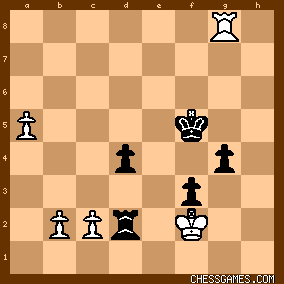
click for larger view44. Kf1?
After this all hope for White was gone. With 44. Kg3!, Popiel would have had some work to do, e.g., 44... Rxc2 [44. Rg2+ also seems to win] 45. a6 Rg2+ (anything else blows the win) 46. Kh4 Rh2+ 47. Kg3 Rh3+ 48. Kh2 Rh7 49. Rf8+ Ke4 50. Rg8 Rh2+ 51. Kg3 f2!! 52. Rxg4+ Ke3 53. Rf4 Rh3+ 54. KxR KxR 55. Kg2 Ke3 56. a7 Ke2 57. a8(Q) f1(Q)+ and Black should win the Queen ending. [Whew!]. But after 44. Kf1?, the win for Black was easy.
44... d3
44...Rxc2 or 44...Kf4 were faster.
45. cxd3
45. Rf8+ Ke4 was also hopeless.
45... Rxb2
Even more immediately decisive was 45...Kf4
The position was now:
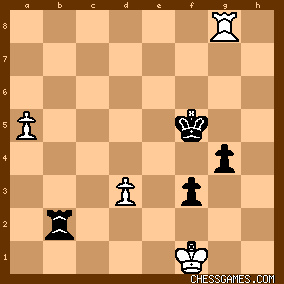
click for larger viewThe game was clearly over and Popiel could have safely resigned here. But he played on. I will cover the remaining moves in my next post on this game. |
|
Jan-31-19
 | | KEG: Post VI
46. Rf8+ Ke5
46...Kg5 was perhaps an even quicker way to close out resistance. 47. a6
This might perhaps frighten a beginner, but it is clear that this pawn is never going to become a Queen. 47... Ra2
Game over you say? Nope. Popiel fought on.
48. d4+ Kxd4
49. a7
Close only counts in horseshoes and hand grenades. 49... Rxa7
Time to resign now?:

click for larger viewUh-uh. Popiel still did not lower his flag:
50. Kf2 Ra2+
51. Kf1
51. Kg3 Rg2+ 52. Kh4 f2 was also futile. But now Popiel faced a mating net. 51... Ke3
52. Re8+ Kf4
53. Re1
White now gets mated quickly, but holding on for a few more moves with 53. Rf8+ or 53. Ke1 would not have been much fun either. The position was now:
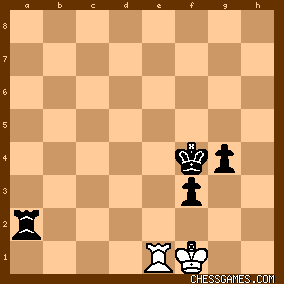
click for larger view53... Rh2
53...g3 is a faster mate, but the text also did the job. 0-1 |
|
|
|
|





